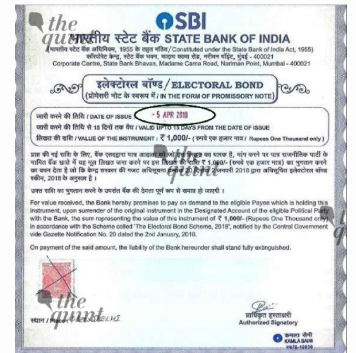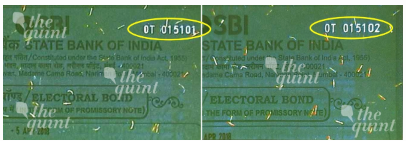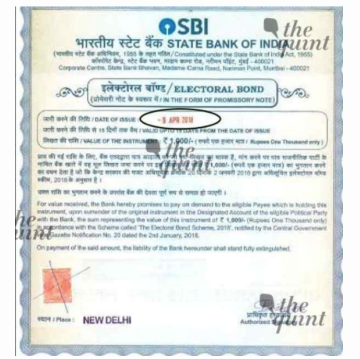In a major exposé, an investigation by The Quint revealed that electoral bonds have hidden alphanumeric numbers printed on them to track down the link between donors and political parties. The apparent out manoeuvring by the government poses a critical question – with the introduction of electoral bonds, are we being subjected to secret surveillance in the name of more ‘transparency’ in political funding?
Electoral bonds were introduced by the government to make donations through a banking channel to political parties by individuals and corporates.
The government said that electoral bonds would curb “the conventional practice of funding the political system in cash and undertake these expenditures in cash”.
They were promised to be anonymous as no one other than the donor themselves were supposed to know which political party they were contributing to.
Sold every quarter for the first 10 days of the month, electoral bonds can be procured from designated branches of the State Bank of India alone.
The Quint’s investigation revealed that while the public will remain clueless about who has donated to which party, the government has access to those details, collated through alphanumeric numbers on the electoral bonds, which are invisible to the naked eye.

The purchaser of the bond is therefore misled into believing that he/she cannot be tracked as no number or name is written on the bond apart from the date of issuance.
This adds to the government’s already burgeoning repository of data, which now may not only have details of our bank accounts and financial transactions, but also our likely political preferences.
The Union Finance Minister Arun Jaitley’s previously assured citizens that political donations via electoral bonds will remain anonymous.
Following the purchase of two electoral bonds worth Rs 1,000 (US$13.95) each, The Quint got forensic tests done to find out whether these bonds carry any hidden letters or numbers.
The first bond was purchased on 5 April 2018 and the second one on 9 April 2018.

Both were purchased at State Bank of India (SBI) branches designated to issue electoral bonds.
The test was conducted at one of the most reputed forensic labs in the country. The lab report revealed the presence of unique alphanumeric numbers on both bonds.

The electoral bond issued on 5 April carries the hidden and unique number OT 015101, while the one issued on 9 April has the unique number OT 015102.
The lab report revealed the hidden serial number was “visible on the right top corner of the original document showing fluorescence when examined under Ultra Violet (UV) Light”.
Naturally, this demands some answers from the government and the State Bank of India, which issues the electoral bonds.
Is someone playing Big Brother here?
Our investigation stands in stark contrast to the Union Finance Minister’s views on electoral bonds.
Mr Jaitley had earlier said “how much each donor has distributed to a political party would be known only to the donor.”
Meanwhile, a top-level State Bank of India official said that the number is merely a “security feature.”
“We don’t believe this code is a tracking mechanism. This was put in those papers as a security feature only,” he added.
The official thus confirmed the presence of unique alphanumeric characters on electoral bonds.
The SBI also issued a second statement, saying: “The number is a security feature and the design and security features have been incorporated at the request of SBI. The process of issuance and payment has been designed in such a manner that the bank will not have any record of the above number either for the donor or political party. Only the count of denomination-wise bonds issued and paid is captured in the records. There is no way to connect which donor has made donation to which party. The bank can share only KYC/AML-related records of donor to an authorised investigating agency or the courts under the relevant laws. Bank is not authorised to share the details with any other government department or agency.”
If the existence of these unique hidden numbers is for security purposes only, then why aren’t the existing watermarks on the electoral bonds enough?
As a result of the series of stories exposing how the electoral bonds scheme is making the system of political donations opaque rather than transparent, a Public Interest Litigation was filed in the Supreme Court on March 5 demanding a stay on the scheme.
The Supreme Court took cognisance of the petition and issued notices to the Election Commission of India and the Government of India.
Since The Quint’s article was cited by the petitioner’s lawyer in the Supreme Court, the Government of India was compelled to accept that a unique hidden alphanumeric serial number exists in the electoral bonds, although their defence was that it is an in-built security feature.
However, a former Reserve Bank of India director said that he has not even seen such ‘security features’ on currency. He also pointed out that the government could have used a watermark as a security feature rather than a unique hidden serial number that enables tracking of the bonds.
This story by Poonam Agarwal was published on 12 April 2018. Read more on The Quint’s website here: https://www.thequint.com/news/politics/hidden-number-on-election-electoral-bond
Published on April 12, 2018, The Quint’s Poonam Agarwal broke her story on hidden alphanumeric numbers printed on electoral bonds. The scheme began to unravel after she decided to purchase a bond, with the permission of the editors, which appeared to have no serial number or space to mention the donor’s name. The government had previously declared that there was no serial number on the electoral bond. The team then decided to do a forensic test on it to check whether the government was telling the truth. Purchasing a second bond helped to prove that the serial numbers were unique. This surfaced the troubling idea that the Indian government was tracking donors. She believes that the purchasers of the bonds should be kept transparent. She said: “There is no need for the government to hide the names of these donors.“Why keep it anonymous? They want to hide names that might be questionable later so the anonymity of the donor should not be there. The process of buying the bond will be fair if anonymity is removed.”.



